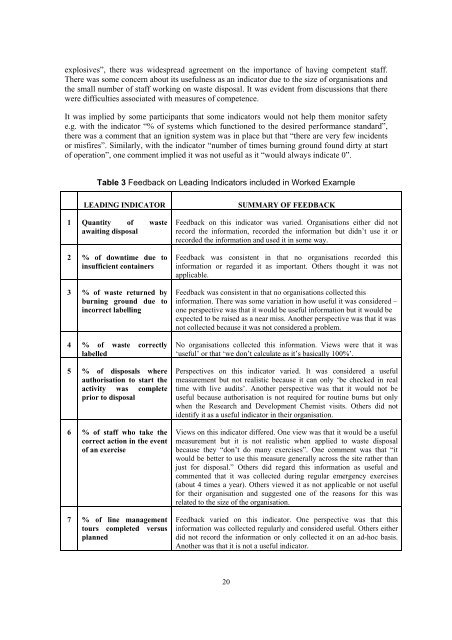RR909 - Safety performance indicators in the explosives sector - HSE
RR909 - Safety performance indicators in the explosives sector - HSE
RR909 - Safety performance indicators in the explosives sector - HSE
You also want an ePaper? Increase the reach of your titles
YUMPU automatically turns print PDFs into web optimized ePapers that Google loves.
<strong>explosives</strong>”, <strong>the</strong>re was widespread agreement on <strong>the</strong> importance of hav<strong>in</strong>g competent staff.<br />
There was some concern about its usefulness as an <strong>in</strong>dicator due to <strong>the</strong> size of organisations and<br />
<strong>the</strong> small number of staff work<strong>in</strong>g on waste disposal. It was evident from discussions that <strong>the</strong>re<br />
were difficulties associated with measures of competence.<br />
It was implied by some participants that some <strong><strong>in</strong>dicators</strong> would not help <strong>the</strong>m monitor safety<br />
e.g. with <strong>the</strong> <strong>in</strong>dicator “% of systems which functioned to <strong>the</strong> desired <strong>performance</strong> standard”,<br />
<strong>the</strong>re was a comment that an ignition system was <strong>in</strong> place but that “<strong>the</strong>re are very few <strong>in</strong>cidents<br />
or misfires”. Similarly, with <strong>the</strong> <strong>in</strong>dicator “number of times burn<strong>in</strong>g ground found dirty at start<br />
of operation”, one comment implied it was not useful as it “would always <strong>in</strong>dicate 0”.<br />
Table 3 Feedback on Lead<strong>in</strong>g Indicators <strong>in</strong>cluded <strong>in</strong> Worked Example<br />
LEADING INDICATOR SUMMARY OF FEEDBACK<br />
1 Quantity of waste<br />
await<strong>in</strong>g disposal<br />
2 % of downtime due to<br />
<strong>in</strong>sufficient conta<strong>in</strong>ers<br />
3 % of waste returned by<br />
burn<strong>in</strong>g ground due to<br />
<strong>in</strong>correct labell<strong>in</strong>g<br />
4 % of waste correctly<br />
labelled<br />
5 % of disposals where<br />
authorisation to start <strong>the</strong><br />
activity was complete<br />
prior to disposal<br />
6 % of staff who take <strong>the</strong><br />
correct action <strong>in</strong> <strong>the</strong> event<br />
of an exercise<br />
7 % of l<strong>in</strong>e management<br />
tours completed versus<br />
planned<br />
Feedback on this <strong>in</strong>dicator was varied. Organisations ei<strong>the</strong>r did not<br />
record <strong>the</strong> <strong>in</strong>formation, recorded <strong>the</strong> <strong>in</strong>formation but didn’t use it or<br />
recorded <strong>the</strong> <strong>in</strong>formation and used it <strong>in</strong> some way.<br />
Feedback was consistent <strong>in</strong> that no organisations recorded this<br />
<strong>in</strong>formation or regarded it as important. O<strong>the</strong>rs thought it was not<br />
applicable.<br />
Feedback was consistent <strong>in</strong> that no organisations collected this<br />
<strong>in</strong>formation. There was some variation <strong>in</strong> how useful it was considered –<br />
one perspective was that it would be useful <strong>in</strong>formation but it would be<br />
expected to be raised as a near miss. Ano<strong>the</strong>r perspective was that it was<br />
not collected because it was not considered a problem.<br />
No organisations collected this <strong>in</strong>formation. Views were that it was<br />
‘useful’ or that ‘we don’t calculate as it’s basically 100%’.<br />
Perspectives on this <strong>in</strong>dicator varied. It was considered a useful<br />
measurement but not realistic because it can only ‘be checked <strong>in</strong> real<br />
time with live audits’. Ano<strong>the</strong>r perspective was that it would not be<br />
useful because authorisation is not required for rout<strong>in</strong>e burns but only<br />
when <strong>the</strong> Research and Development Chemist visits. O<strong>the</strong>rs did not<br />
identify it as a useful <strong>in</strong>dicator <strong>in</strong> <strong>the</strong>ir organisation.<br />
Views on this <strong>in</strong>dicator differed. One view was that it would be a useful<br />
measurement but it is not realistic when applied to waste disposal<br />
because <strong>the</strong>y “don’t do many exercises”. One comment was that “it<br />
would be better to use this measure generally across <strong>the</strong> site ra<strong>the</strong>r than<br />
just for disposal.” O<strong>the</strong>rs did regard this <strong>in</strong>formation as useful and<br />
commented that it was collected dur<strong>in</strong>g regular emergency exercises<br />
(about 4 times a year). O<strong>the</strong>rs viewed it as not applicable or not useful<br />
for <strong>the</strong>ir organisation and suggested one of <strong>the</strong> reasons for this was<br />
related to <strong>the</strong> size of <strong>the</strong> organisation.<br />
Feedback varied on this <strong>in</strong>dicator. One perspective was that this<br />
<strong>in</strong>formation was collected regularly and considered useful. O<strong>the</strong>rs ei<strong>the</strong>r<br />
did not record <strong>the</strong> <strong>in</strong>formation or only collected it on an ad-hoc basis.<br />
Ano<strong>the</strong>r was that it is not a useful <strong>in</strong>dicator.<br />
20

















